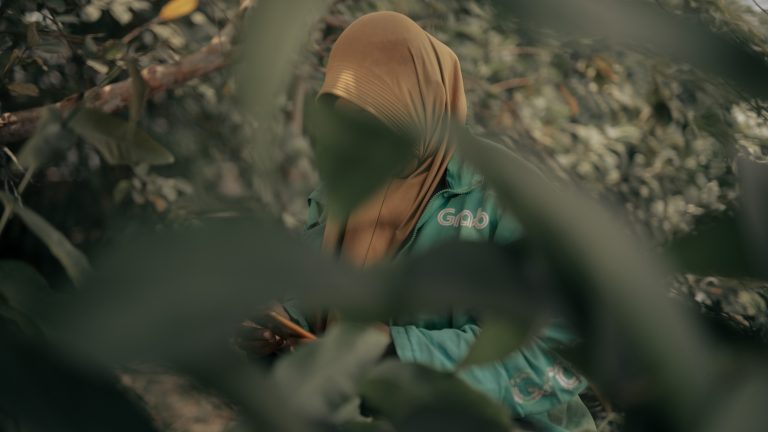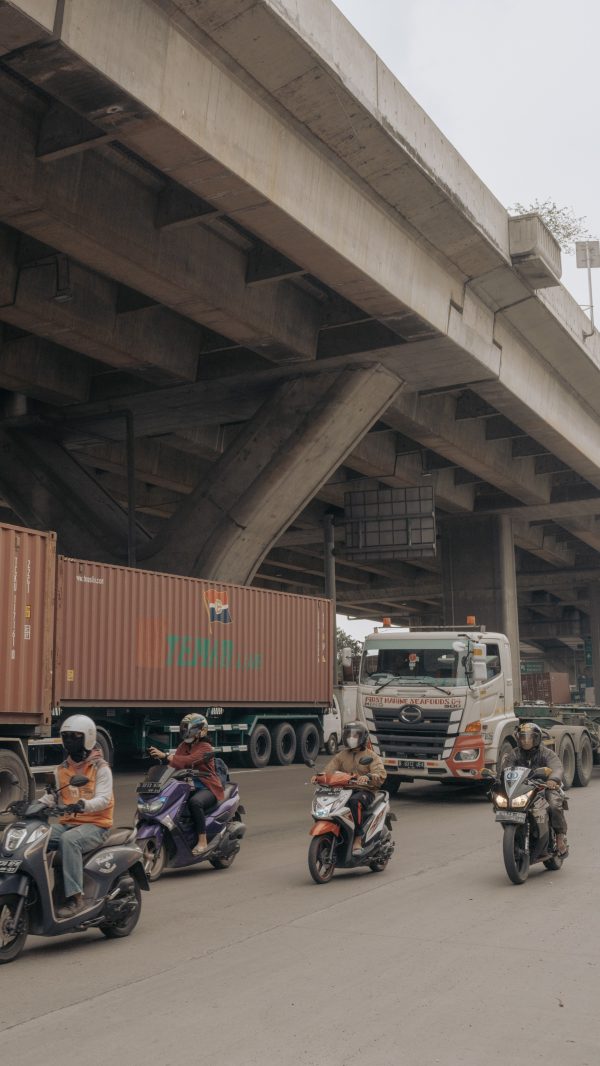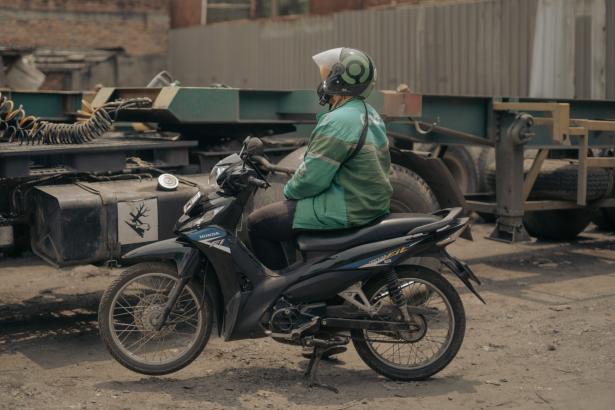For Iin, a 42-year-old woman in West Jakarta, Indonesia, being a ride-hailing driver sometimes means being the passenger. “If I got an order from a male passenger, I always asked: ‘I am a woman, is that okay with you?’” she recounted to Rest of World recently, at a rest area for drivers like her. “If they said, ‘Okay,’ I would ask again: ‘Do you want to drive?’”
Iin, who drives a motorcycle, said she’s heard many stories from other women drivers about experiencing inappropriate contact from male passengers sitting behind them. They touch their thighs or stomachs, sometimes under the guise of trying to stay on the bike.
“I felt safer when the male passenger wanted to drive. It prevented me from sexual harassment. If I sat in the back, they could not touch me,” she said.
Iin has been driving since 2018 — first, for Gojek, and now for Borzo, an Amsterdam-based courier service. She spoke under a pseudonym, to avoid reprisals from the company for talking to the press.
Iin had moved to Jakarta after a divorce, looking to support her daughter’s education. At the time, ride-hailing was the most exciting, fast-growing tech business in Indonesia. Driving for a company like Gojek made sense: She didn’t need more than a driver’s license and two wheels, had the freedom to choose her hours, and could make decent cash.
But, as it turns out, many Indonesian men don’t want the indignity of being driven by female drivers. Some passengers pitied Iin — for needing to do tough manual work as a woman, they told her. And it was harder for her to get gigs than her male counterparts. Iin said almost half of her male customers canceled their requests after looking at her profile and realizing she was female.
Driving for ride-hailing companies was once pitched as a perfect opportunity for women to win independence by earning their own incomes. In 2018, the arrival of female Uber drivers in Saudi Arabia was touted as a new era of freedom; the same year, UAE equivalent Careem targeted women for recruitment. In Indonesia, meanwhile, companies like Grab and Gojek recruited women drivers as part of their strategies for ballooning growth. But, five years on, the reality has been far less rosy. Rest of World spoke with women riders, activists, and researchers who described these women as being saddled with two jobs: physically taxing full-time employment, and the full weight of domestic duties.
Many are forced to stick with the work for lack of alternatives, drivers told Rest of World. The bigger ride-hailing companies are aware of the problems. Grab runs anti-sexual harassment trainings for all drivers. The company also has the “LadyGrab” program, through which women can work for GrabFood, its food delivery service, so they don’t have to take on passengers and deal with potential discrimination. Similarly, Gojek has held anti-violence training programs, and this January, launched a feature that gives female drivers the option to deliver food and packages rather than take passengers. For the women on the app, however, it’s a unique kind of suffocation.

Inah, a 38-year-old rider for Grab in North Jakarta.
“No one wants to make a living on the street like this. If only I had another choice, I’d want to be loved and cared for,” Inah, a 38-year-old widow who has delivered food for Grab since 2021, told Rest of World. “If a woman takes this job, she desperately needs money to live.” Her voice trembled, and she asked to pause the interview while she collected herself.
Women make up only 5% of all ride-hailing drivers in Indonesia, according to data published by Gadjah Mada University. That number may have increased over the pandemic, says Prima Yustitia, a researcher at the State University of Jakarta and community development officer, who had conducted a study on the sector, published in 2020. “A breadwinner woman needs an easy-to-apply-for job … like being a rider or courier,” she told Rest of World.
“If a woman takes this job, she desperately needs money to live.”
It’s not unusual for women to be the family breadwinners in Indonesia’s working classes. They might run small businesses or do multiple informal jobs, like cleaning and laundry. But it remains unusual for them to be out on the streets as a driver for an app, a male-coded job. Given their lower incomes, these women also can’t outsource their domestic jobs the way that a woman with a corporate career might. When they take on gig work and retain their domestic duties, they’re lumped with a “double burden,” said Yustitia.
Running through North Jakarta is a 13-kilometer dusty, pothole-riddled, death trap of a road. Locals call it “Jalur Tengkorak,” or the “Skull Path.” Container trucks and motorbikes dodge each other down the highway, cloaked with a miasma of dust and exhaust pollution.

Traffic around Cilincing, North Jakarta, a notoriously dangerous area for motorbike riders.
Inah has driven this route daily for two years for GrabFood. She spoke to Rest of World under a pseudonym, as she feared reprisal from her company and colleagues for speaking to the media. “Last night, a teenager just died. Hit by a truck. Happens again and again on that road,” she said. When she hears news of that kind, she reminds herself to drive patiently. She can’t control much else, she said.
Inah rises before the sun does, saying her prayers, doing laundry, and packing off her children — one teenager, two elementary school-aged — to school. At 8 a.m., she opens the GrabFood app and begins taking orders.
At lunchtime, she pauses to pick up her children from school, prepares their meals, and then heads out again to drive well into the night. When she gets back around 11 p.m., she’ll often help the children with their homework. The only time she isn’t working, she said, is when she sleeps.
Inah chose food delivery because of its relative safety, and the fact that she has a choice whether to accept a job or not — not the case when taking on passengers. But she still has to deal with the lechery of fellow drivers. As a widow, she’s unprotected. “You’ve been alone so long! What would I need to do to turn you on?” a driver asked her recently, as Grab drivers took a break in a rest area. The other men sniggered. Inah lowered her eyes and stayed silent.

Sari, a 25-year-old rider for Gojek in North Jakarta.
Tyas Widyastuti, director of the 2-Wheels and logistics businesses of Grab Indonesia, told Rest of World the company prioritizes driver safety and security. Grab Indonesia has held various training programs on the prevention and treatment of sexual violence, attended by hundreds of women drivers. The company also offers services like GPS tracking and a dedicated helpline to provide assistance “in a state of emergency.”
“Our mission is creating economic development for society. Therefore, Grab adheres to the partnership principle, which enables our drivers/partners to flexibly set their working hours,” wrote Tyas in an email. Gojek did not respond to specific questions from Rest of World, but said the company “expressly prohibits various types of violence including sexual violence in its ecosystem,” and cited various safety policies such as Select Service, which tailors jobs to each driver, allowing women to select low-contact gigs.
Lily Pujiati, founder and chairperson of labor union Serikat Pekerja Angkutan Indonesia (SPAI), is familiar with the insecurities of gig work. She signed up to be a driver in 2021 to better understand their circumstances.
The issue is not just about getting sick or injured, though these are daily risks for anyone who drives for a platform. “Women riders [don’t have] rights for menstrual leave, maternity leave, compensation if they can’t ride because of pregnancy,” she said to Rest of World.

Lily Pujiati, the founder and chairperson of Serikat Pekerja Angkutan Indonesia.
The incentives of the app favor the most disciplined and high-performing workers only, Arif Novianto, a researcher at Gadjah Mada University’s Institute of Governance and Public Affairs, told Rest of World. Every day, drivers used to need to hit a certain number of points, which would gain them income multipliers, or “incentives,” to max out their takings.
Nowadays, the incentives have disappeared, but the points system remains. If drivers take a break from the app for a few days, their points balance shrinks and they receive fewer orders when they log back in, drivers for both Grab and Gojek told Rest of World. Their income drops accordingly, so there’s punishment, they feel, but no reward.
Sari, a 25-year-old rider for Gojek, learned this the hard way. She spoke to Rest of World one afternoon as she drove home, recounting an earlier era when she could earn a good living — a “golden era,” she called it. In 2020, she worked from 5 a.m. to 9 p.m., streaking across Jakarta and even beyond, consistently hitting her points quota and earning 350,000 rupiah ($23) a day — the maximum rate in 2020. It was exhilarating.
“But I got exhausted. I was sick, and could not work for several days,” Sari told Rest of World, requesting to use her nickname for fear of professional repercussions. By the time she returned to work, the app had decreased her reward points, and she waited longer to receive orders.
With few options to return to school or make the leap into an office job, she made the decision to work less. Now, she helps her mother make street food like banana fritters to sell at their stall. She drives the rest of the time. Despite still working 13 hours a day, her income has fallen by about 75%.
Sari is still determined to work for Gojek. Her mother reminds her to put eye drops in every night before she goes to sleep. She doesn’t want Sari to become like her brother, who underwent eye surgery from the air pollution hitting his eyes. He is also a driver.
Iin has no plans to leave her role as a courier, either. She’s somewhat grateful for the job, compared to her hellish experiences as a ride-hailing driver. Her daughter, who has grown up and found work in another town, often asks, “How long are you going to live like this?” Iin has no answer.
Joan Aurelia Rumengan is a Jakarta-based journalist and video


Spread the word